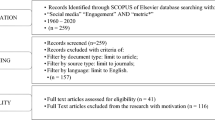Abstract
The advent of digital communications has proliferated the engagements between customers and businesses of all varieties including university athletic programs. Interaction and engagement through social media content play a critical role in developing the relationship between fans and their favorite colligate teams. In this study, we reviewed the existing literature pertaining to the use of sentiment analysis and content categorization for fan engagement in the sports industry. Dozens of sources were examined, and their methodologies were explored. We present an analytic framework that can be used by sports organizations in their efforts to harness the power of AI and social media. The framework encompasses multiple stages related to textual data: data collection, data preparation, sentiment mining, and content categorization. In particular, this study demonstrates the use of text mining and sentiment analysis to provide athletic departments with more efficient and effective data understanding. In turn, this process will yield improved fan engagement to scale without increased expenditures. Using the textual data gathered from social media for a Basketball team at a major university in the United States, multiple analytical models were created using several different text mining packages, each one seeking to classify the polarity of the fan comments being examined. The study explored the possibility of classifying comments as positive or negative at the statement level. Statements were further categorized according to the subject matter of the comment. Inconsistencies were found between what the models identified and fan sentiment. Updating these models and the use of more effective text mining algorithms resulted in improved performance. Ultimately, it was determined that text mining and sentiment analysis models would be capable of performing the necessary analysis. Implications for research and practice are discussed.



Similar content being viewed by others
References
Ågerfalk PJ (2013) Embracing diversity through mixed methods research. Taylor & Francis, Abingdon
Carlson J, O’Cass A (2012) Optimizing the online channel in professional sport to create trusting and loyal consumers: The role of the professional sports team brand and service quality. J Sport Manag 26(6):463–478
Feuerriegel S, Proellochs N, Feuerriegel MS (2018) Package ‘SentimentAnalysis’: London
Filo K, Lock D, Karg A (2015) Sport and social media research: A review. Sport Manag Rev 18(2):166–181
Hobbs JR, Walker DE, Amsler RA (1982) Natural language access to structured text. Paper presented at the Proceedings of the 9th conference on Computational linguistics-Volume 1
Hur Y, Ko YJ, Valacich J (2011) A structural model of the relationships between sport website quality, e-satisfaction, and e-loyalty. J Sport Manag 25(5):458–473
Ioakimidis M (2010) Online marketing of professional sports clubs: Engaging fans on a new playing field. Int J Sports Mark Spons 11(4)
Jaitly A, Ahuja S (2018) Improving the accuracy for sentence level sentiment analysis. Int J Adv Rese Comput Sci 9(4):37
Karamibekr M, Ghorbani AA (2013) Sentence subjectivity analysis in social domains. Paper presented at the 2013 IEEE/WIC/ACM International Joint Conferences on Web Intelligence (WI) and Intelligent Agent Technologies (IAT)
Mustafaraj E, Finn S, Whitlock C, Metaxas PT (2011) Vocal minority versus silent majority: Discovering the opionions of the long tail. Paper presented at the 2011 IEEE Third International Conference on Privacy, Security, Risk and Trust and 2011 IEEE Third International Conference on Social Computing
Parganas P, Anagnostopoulos C, Chadwick S (2015) ‘You’ll never tweet alone’: Managing sports brands through social media. J Brand Manag 22(7):551–568
Pozzi FA, Fersini E, Messina E, Liu B (2016) Sentiment analysis in social networks. Morgan Kaufmann, Burlington
Pronschinske M, Groza MD, Walker M (2012) Attracting Facebook’fans’: The importance of authenticity and engagement as a social networking strategy for professional sport teams. Sport Mark Q 21(4):221
Santos TO, Correia A, Biscaia R, Pegoraro A (2019) Examining fan engagement through social networking sites. Int J Sports Mark Spon
Sharda R, Delen D, Turban E (2016) Business intelligence, analytics, and data science: a managerial perspective. Pearson, London
Surjandari I, Wayasti RA, Laoh E, Rus AMM, Prawiradinata I (2019) Mining public opinion on ride-hailing service providers using aspect-based sentiment analysis. Int J Technol 10(4):818–828
Vale L, Fernandes T (2018) Social media and sports: driving fan engagement with football clubs on Facebook. J Strateg Mark 26(1):37–55
Venkatesh V, Brown SA, Sullivan YW (2016) Guidelines for conducting mixed-methods research: An extension and illustration. J Assoc Inf Syst 17(7):2
Zadeh A, Jeyaraj A (2018) Alignment of business and social media strategies: insights from a text mining analysis. J Bus Anal 1(2):117–134
Zadeh AH, Sharda R (2014) Modeling brand post popularity dynamics in online social networks. Decis Support Syst 65:59–68
Author information
Authors and Affiliations
Corresponding author
Additional information
Publisher’s Note
Springer Nature remains neutral with regard to jurisdictional claims in published maps and institutional affiliations.
Appendix
Appendix
Rights and permissions
About this article
Cite this article
H. Zadeh, A. Quantifying fan engagement in sports using text analytics. J. of Data, Inf. and Manag. 3, 197–208 (2021). https://doi.org/10.1007/s42488-021-00052-4
Received:
Accepted:
Published:
Issue Date:
DOI: https://doi.org/10.1007/s42488-021-00052-4




